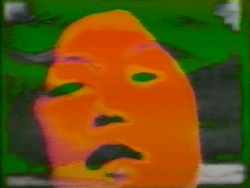Shigeko Kubota
Shigeko Kubota brought a singular sensibility to her extensive body of video sculptures, multi-media installations, and single-channel videos. Over her five-decade career, Kubota forged a lyrical confluence of the personal and the technological, often merging vibrant electronic processing techniques with images and objects of nature, art and everyday life. Her distinctive fusions of the organic, the art historical and the electronic are at once poetic and witty.
An active participant in the international Fluxus art movement in the 1960s, Kubota was strongly influenced by the art and theories of Marcel Duchamp and John Cage. Focusing on several, often interconnected themes, her works include installations that pay direct homage to Duchampian ideas and icons (the Meta-Marcel and Duchampiana series, which includes the video sculpture Nude Descending a Staircase, 1976); those that reference Japanese spiritual traditions of nature and landscape, particularly water and mountains (River, 1981, Niagara Falls, 1985); and an ongoing, diaristic project of chronicling her personal life on video.
This latter, autobiographical series of single-channel pieces, collectively entitled Broken Diary, evolved since 1970. In her poignant and wry observations of the everyday, Kubota merges her signature electronic processing with art historical and cultural references and a strong sense of female identity. For Kubota, the "everyday" includes a chess match between Duchamp and Cage and travels in Europe, Korea, Japan, and the American Southwest. An intimate video journal that functions as a record of personal and collective memory, these tapes take the form of informal, subjective documentaries. The later installments of her video diary often focused on her relationship with her late husband, artist Nam June Paik.
Kubota was born in 1937 in Niigata, Japan and died in 2015. She received a B.A. in sculpture from Tokyo University of Education, and studied at New York University and the New School for Social Research. In 1964, she moved to New York; in the same year she became the Vice Chairman of the Fluxus Organization.
She taught at the School of Visual Arts, and was video artist-in-residence at both Brown University and the School of the Art Institute of Chicago. From 1974 to 1982 she was the video curator at Anthology Film Archives. Kubota was the recipient of numerous grants and awards, including a Deutscher Akademischer Austauschdienst Fellowship in Berlin, National Endowment for the Arts Fellowships, New York State Council on the Arts grants, a Guggenheim Fellowship, a Rockefeller Foundation Fellowship, and an NEA/Visual Arts grant.
Her work is in the permanent collections of The Museum of Modern Art, New York, and the Toyama Museum of Art, Japan. Kubota's video sculptures, installations and videos have been exhibited internationally at institutions including the Rene Block Gallery, New York; The Museum of Modern Art (Projects), New York; Documentas 6 and 8, Kassel, Germany; Folkwang Museum, Essen, Germany; Kunsthaus, Zurich; Whitney Museum of American Art, New York; Stedelijk Museum, Amsterdam; the Kulturhuset, Stockholm; Japan Society, New York; The Kitchen, New York; New Langton Arts, San Francisco; Kongress Halle, Berlin; and the Museum of Contemporary Art, Chicago. She participated in the 1990 Venice Biennale and the 1990 Sydney Biennale. A retrospective of her work was presented at the American Museum of the Moving Image, New York in 1991. In 1996, she was the subject of a one person show at the Whitney Museum of American Art, New York.
Kubota lived in New York and Miami until her death in 2015.








